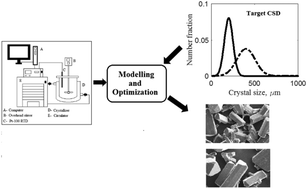Particle engineering by optimization for the unseeded batch cooling crystallization of l-asparagine monohydrate
Abstract
Due to the stochastic nature of the nucleation event, producing the desired crystal size distribution (CSD) consistently is a challenging task in an unseeded crystallization process. A predictive dynamic model based on a population balance framework was developed for the unseeded batch cooling crystallization of L-asparagine monohydrate (LAM) from its aqueous solution. The nucleation and growth kinetic parameters were estimated simultaneously from the experimental data by combining the population balance model with a nonlinear parameter estimation technique. The model was then used to solve various optimization problems related to particle engineering. Both single objective and multi-objective optimization problems are solved to determine the optimal operating conditions for various objective functions reflecting the different desired attributes of the CSD. Finally, an attempt is made to achieve the desired target shape of the CSD by solving an appropriate dynamic optimization problem. The experimental implementation of the obtained optimal operating conditions clearly demonstrates the predictive ability of the developed model and the use of the optimization approach as a useful tool for particle engineering.



 Please wait while we load your content...
Please wait while we load your content...